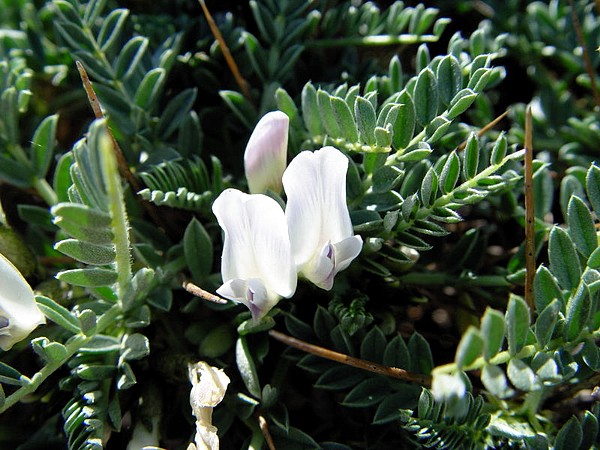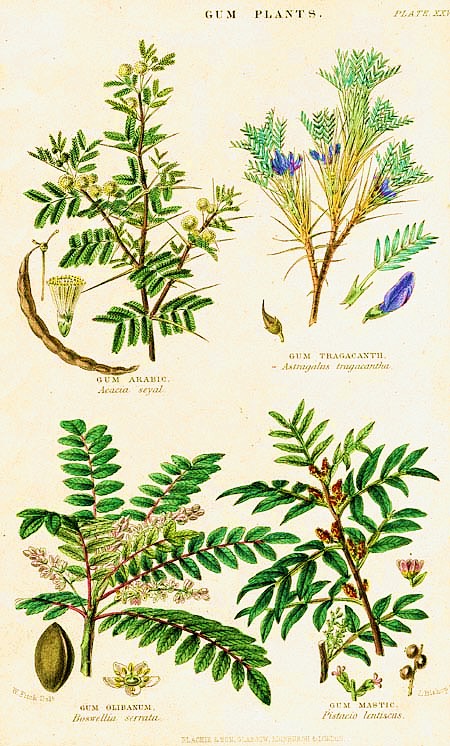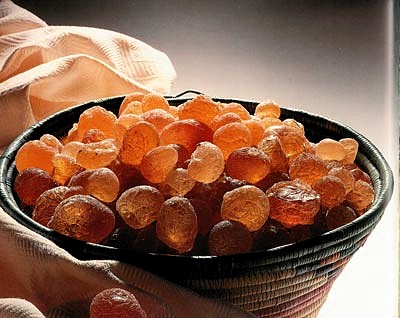Lessico
Gomma adragante
Astragalus tragacantha

Astragalus tragacantha ssp vicentinus
Adragante deriva dal greco tragákantha = spina del caprone, una delle specie di astragalo. Termine usato soprattutto come aggettivo per indicare una gomma vegetale (gomma adragante) che trasuda dalle fenditure dei rami di alcune specie di astragalo. Da Astragalus tragacantha e Astragalus gummifer – famiglia Papilionacee - si estrae la gomma adragante usata nelle industrie farmaceutiche, alimentari e in tintoria. Queste due specie sono originarie dell'Asia Minore e dell'Armenia.
Gomme vegetali

Quattro
produttori di gomme
gomma arabica![]() - gomma adragante
- gomma adragante
incenso![]() - mastice
- mastice![]()
Sono costituite da composti macromolecolari del gruppo dei carboidrati e si disciolgono in acqua formando soluzioni colloidali più o meno dense secondo la concentrazione e la natura della gomma, mentre sono insolubili in alcol e negli altri solventi organici. La più nota è la gomma. arabica, ottenuta da alcune specie del genere Acacia, in particolare da Acacia senegal.

Gomma arabica
La gomma arabica si presenta in granuli gialli o appena giallognoli e semitrasparenti nei tipi più pregiati. Le zone di maggior produzione sono il Senegal e la zona sudanese della valle del Nilo. Per ottenerla dalle piante si asportano dal tronco delle strisce di corteccia avendo cura di non intaccare il legno sottostante: dopo qualche decina di giorni la zona scortecciata appare coperta da uno straterello di gomma; il raccolto si ripete di tempo in tempo. Oltre che per preparare la soluzione al 20% circa usata come adesivo, ma in buona parte oggi sostituita dalle gomme artificiali a base di destrina e di amido, la gomma arabica trova largo impiego nella preparazione di pasticche gommose in campo dolciario e nell'industria farmaceutica, nella quale viene inoltre usata per dare compattezza alle compresse e alle pastiglie.
La gomma adragante, ricavata da alcune specie di astragalo, si presenta in piastrine bianche o giallognole; in acqua si rigonfia e forma poi una soluzione fortemente mucillaginosa. Viene usata nella tecnica farmaceutica analogamente alla gomma arabica e inoltre come addensante nella preparazione di salse e sciroppi, nella finitura e nella tintura a stampa dei tessuti, ecc. Di qualità meno pregiata sono le gomme ricavate da alcune specie del genere Sterculia, note in commercio con il nome di gomma karaya, e quelle ricavate da Anogeissus latifolia, note come gomma ghati.
Tragacanth is a natural gum obtained from the dried sap of several species of Middle Eastern legumes of the genus Astragalus, including Astragalus adscendens, Astragalus gummifer, and Astragalus tragacantha. Some of these species are known collectively under the common names "goat's thorn" and "locoweed". The gum is sometimes called "shiraz gum , "gum elect" or "gum dragon". The name derives from tragos and akantha, which means in Greek "goat" and "thorn", respectively. Iran is the biggest producer of the best quality of this gum.
Gum tragacanth is a viscous, odorless, tasteless, water-soluble mixture of polysaccharides obtained from sap which is drained from the root of the plant and dried. The gum seeps from the plant in twisted ribbons or flakes which can be powdered.
When added to water, tragacanth absorbs water and becomes a gel which can be stirred into a paste. The gum is used in veg-tanned leatherworking as an edge slicking and burnishing compound and is occasionally used as a stiffener in textiles. It contains an alkaloid that has historically been used as an herbal remedy for such conditions as cough and diarrhoea. As a mucilage or paste it has been used as a topical treatment for burns. It is used in pharmaceuticals and foods as an emulsifier, thickener, stabilizer, and texturant.
Also, it is the traditional binder used in the making of artist's pastels, as it does not adhere to itself the same way other gums (such as gum arabic) do when dry. Gum Tragacanth is also used to make a paste used in Floral Sugarcraft to create life-like flowers on wires used as decorations for cakes. It makes a paste which dries brittle in the air and can take colourings. It enables the user to get a very fine, delicate finish to their work.
Gum tragacanth is less common in products than other gums, such as gum arabic or guar gum, mostly due to the fact that most tragacanth is grown in Middle Eastern countries which have shaky trade relations with countries where the gum is to be used. Commercial cultivation of tragacanth plants has generally not proved economically worthwhile in the west, since other gums can be used for similar purposes.